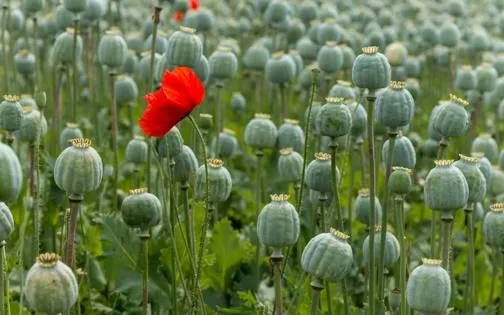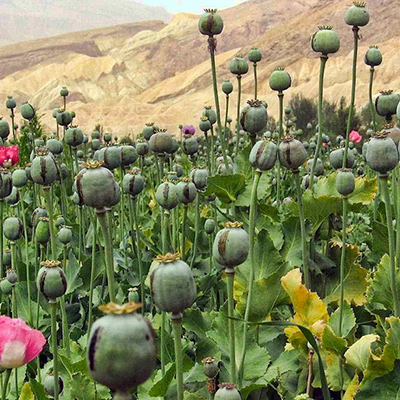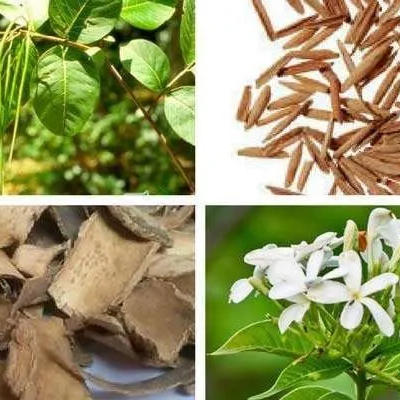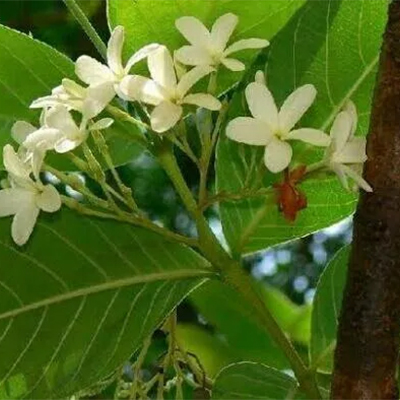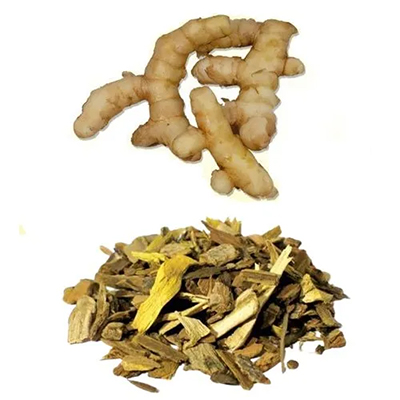On This Page
Ahiphena – Opium Poppy or Breadseed Poppy
Introduction
Opium botanically known as Papaver somniferum is cultivated in Eastern countries and India only under license. Due to narcotic action, in many countries the cultivation of Ahiphena is illegal. Ahiphena is the source of various pharmaceutical alkaloids including morphine, codeine, etc. A milky latex is obtained from Ahiphena known as opium, which is reported to be the most common substance used for drug abuse after Cannabis globally. Ahiphena is an annual plant and is native to turkey. In Brihat Trayi texts, Ahiphena is not mentioned. Sarangdhara quotes Ahiphena under Vyavaya Dravya. In Nighantus of Ayurveda, it was first mentioned in Dhanvantari Nighantu under the name Aafuk. In Raja Nighantu, Ahiphena comes under the underclass of Upvisha and is used in various Kalpanas (formulations). Its various formulations are mentioned in Ayurveda and mainly are for Gastrointestinal diseases.
Basonym of Ahiphena
अहे फेन गरलमिव तीक्ष्ण गुण त्वात। वाचस्पत्य अहे सर्पस्य फेनम गरल मिव अत्य उग्र त्वात। (राज निघण्टु)
Latex is very strong like veom of cobra.
Synonyms of Ahiphena
- Synonyms of Ahiphena as per its Ksheer (Latex)
फणि फेन – फणिनां फेन इव उग्र गुण त्वात।
Latex of Ahiphena is as strong as the venom of the snake.
नागफेन – Ksheera (latex) is strong as snake venom.
आफूक – Ahiphena is a source of opium.
खस फल क्षीर – Injury is done to fruit yields latex.
- Synonyms of Ahiphena as per its Bija (seeds)
सूक्ष्म बीज – Seeds of Ahiphena are very small.
सूक्ष्म तण्डुल – Small seeds like grains.
Regional Names of Ahiphena
- Khaskhas (Hindi)
- Aphimu (Kannada)
- Opium, Poppy seeds (English)
- Karappu (Malayalam)
- Khas Khas (Marathi)
- Nalla mandu (Telugu)
- Postodheri (Bengali)
Botanical Name
Papaver somniferum Linn.
Papaver means a member of the Papaveraceae family.
Somniferum means producing sleep.
Family
Papaveraceae
Ayurveda Reference for Ahiphena

Scientific Classification of Ahiphena
| Kingdom | Plantae |
| Class | Dicotyledons |
| Subclass | Polypetalae |
| Series | Thalamiflorae |
| Order | Ranales |
| Family | Papaveraceae |
| Genus | Papaver |
| Species | somniferum |
Classification of Ahiphena – As Per Charaka and Sushruta
No description in Charaka and Shusruta.
External Morphology of Ahiphena
- Habit: An annual herb with latex.
- Root: Taproot, branched.
- Stem: Erect, herbaceous, green, cylindrical, hairy with latex
- Leaf: Simple, alternate, sessile, sheathing base, exstipulate, lobed, unicostate, reticulate vein.
- Inflorescence: Solitary, terminal Cymose
- Flower: Pedicellate, actinomorphic, bisexual, complete, hypogynous, large, showy, red, or white-colored.
- Fruit: Small, white, or black.
Opium is the dried juice of the poppy. The unripe capsule is incised and the white juice which exudes is collected and dried to obtain opium.
Varieties of Ahiphena
In Nighantu Ratnakaram as per action four varieties of Ahiphena have been described:
| Types as per Ratnakar | Variety | Action |
| Jarana | White variety | Acts as digestive |
| Marana | Black variety | Cause death |
| Dharana | Yellow variety | Acts as Rasayana |
| Sarana | Different colors | Removes metabolic residue from the body |
In Rajnighantu and Nighantu Ratnakara according to the colors of the flower four varieties are described:
| Varieties | Color of flower |
| Shweta | White flower |
| Pitta | Yellow flower |
| Krishna | Black flower |
| Chitra | multicolored |
Different Species of Ahiphena
- Papaver nigrum DC- Cultivated in Southern Europe
- Papaver glabrum Bios- Cultivated in Turkey, Egypt, and Iran.
- Papaver album DC- Cultivated in India & Yugoslavia
- Papaver setigerum DC- Wild in Southern Europe
k. C. Chunekar mentioned three varieties of opium in the market viz.
- Patna or Bengali opium from Bihar and Bengal.
- Malva opium from Gwalior, Bhopal, Vadodara, etc.
- Varanasi opium from Uttar Pradesh, Uttranchal.
Distribution of Ahiphena
A native of West Asia now grows in Uttar Pradesh, Rajasthan, Punjab, and Madhya Pradesh.
The Useful Part of Ahiphena
Raw opium (the inspissated juice): It is the dried latex obtained by the incision from the unripe fruit capsules of Papaver somniferum, dried or partly dried or partly dried by heat or spontaneous evaporation and worked into somewhat irregularly shaped masses or molded into masses of more uniform size and shape.
Poppy seeds: Seeds are collected from the poppy capsules. The seeds are very small, about 1 to 1.5 mm in diameter.
Poppy straw: Dried opium poppies are referred to as “Poppy straw”.
Seed oil which is popular with the name Khasa Phala or Khas Bija
Poisoning Effects of Ahiphena
- External skin contact: Its contact with skin may produce erythema, urticaria, and itching.
- Internal use:
- When Ahiphena is orally consumed, its symptoms appear within half an hour. If taken in Injected form it needs 3 to 4 minutes to show symptoms.
- It first stimulates then depresses and finally paralyzes the nerve centers.
These Symptoms will Manifest in Three Stages
- Stage 1 (Stage of excitement): Increased sense of well-being, mental activity, freedom from anxiety, flushing of the face, tachycardia, etc.
- Stage 2 (Stage of stupor): Symptoms like headache, nausea, vomiting, sense of weight in the limbs, giddiness, stupor, contracted pupils, cyanosis of lips, etc.
- Stage 3 (Stage of Coma): Deep coma, flaccid muscles, diminished reflexes, pinpoint pupil, Cheyenne- strokes breathing, etc.
Nutritional Facts of Ahiphena (Poppy Seeds)
| Principle | Nutritional Value/ 100 grams |
| Energy | 525 KCal |
| Total fats | 41. 56 grams |
| Carbohydrates | 28. 13 grams |
| Proteins | 17. 99 grams |
| Vitamin A | 0 IU |
| Vitamin C | 1 mg |
| Vitamin E | 1.77mg |
| Vitamin K | 0 mg |
| Calcium | 1438 mg |
| Copper | 1.627 mg |
| Iron | 9.76 mg |
| Magnesium | 347 mg |
Important Phytoconstituent of Ahiphena
Crude opium contains about 25 alkaloids, like Morphine (10%), Codeine (0.05%),
Papaverine, Narcotine, Meconic acid, Apomorphine, etc.
These form 2 groups:
- The phenanthrenes: Morphine (10%), codeine (0.5%), and thebaine (0.3%), which are narcotic.
- The isoquinolines: Papaverine (1%) and narcotine (6%), which are mild analgesics but not narcotics. Papaverine may act as muscle relaxant.
Recent Research on Ahiphena
- Analgesic
- Sedative
- Hypnotic
- Respiratory depressant
- Emetic
- Narcotic
- Anti-allergic
- Sexual stimulant
- Anti-bacterial
- Bronchodilator
- Narcotic activity
- Antidiarrheal activity
Codeine – as antitussive agent
Papaverine – as muscle relaxant
Morphine – to treat acute angina
Rasa-Panchaka (Properties) of Ahiphena (Niryasa; Latex)
| Rasa (Taste) | Tikta (bitter) |
| Guna (Virtue) | Ruksha (dry), Ushana (hot) |
| Virya (potency) | Ushana (hot potency) |
| Vipaka (post-digestion) | Katu (pungent) |
Rasa-Panchaka (Properties) of Ahiphena (Phala Twaka; Fruit bark)
| Rasa (Taste) | Tikta (bitter), Kashaya (astringent) |
| Guna (Virtue) | Ruksha (dry), Laghu (light) |
| Virya (potency) | Sheet (cold potency)) |
| Vipaka (post-digestion) | Katu (pungent) |
Rasa-Panchaka (Properties) of Ahiphena (Beej; Seed)
| Rasa (Taste) | Madhura (sweet), Kashaya (astringent) |
| Guna (Virtue) | Guru (heavy) |
| Virya (potency) | Sheet (cold potency) |
| Vipaka (post-digestion) | Madhura (sweet) |
Karma: Maadaka, Madkari, Nidrajanan, Stambhana, Shoolprashmana, Rakta Stambhaka, Sweda Janana, Dhatu Shoshana.
Specific Karma
- Karma (Action) of Ahiphena on Dosha: Niryasa is Kaphahara because of its Ushna Virya. Beeja (seed) is Pittahara because of their Sheeta Virya.
- Karma (Action) of Ahiphena on Dhatu: Niryasa is Dhatu Shoshana. Phala Twaka is Dhatu shoshaka. Beeja is Dhatu Vardhaka.
- Karma (Action) of Ahiphena on Mala: Niryasa is Stambhaka and Swedajanaka. Phal Twaka of Ahiphena is Grahi.
Prayogarha Vyadhi (Therapeutic indication) of Ahiphena – As Per Part Used
- Niryasa (latex): Niryasa of Ahiphena is Grahi, Ruchikara, Vedna Sthapaka, Agni Vardhak, Grahi, Nidrajanka.
- Phala Twak (fruit bark): Grahi, Ruchya, Mohkara, Agni Vardhak.
- Beej (seed): Balya, Vrishya
Internal Indication of Ahiphena
- Vedna Pardhana Vikara
- Gridhasi
- Udarshool
- Apsmara
- Dhanustambha
- Aantrik Jwara
- Aptantraka
- Kamp Vata
External Indication of Ahiphena
- Sandhi Shotha
- Shotha- Pida
- Arsha Guda Vikara
- Netra, Karna Shotha Vedna
Aamyik Prayog (Therapeutic Uses) of Ahiphena
- Atisara (Diarrhea): Ahiphena mixed with the bark of Kupilu and honey checks all types of diarrhea. (Vaidya Manorma. 6. 3)
- Kasa and Jvara (cough and Fever):
- Yavanadi Kwatha (Bhava Prakasha Chikitsa Sthana 1/ 383)
- Khaskhas Niryuha (Siddha Bhaishjya Mannimala. 4/ 325- 326)
- Darunaka (Dandruff): The seeds pounded with milk and pasted to destroy dandruff. (Sharanghdhara Samhita. 3. 11. 19)
Matra (Therapeutic Administration and Dosage) of Ahiphena
- Afima (latex or exudate): 30- 125mg
- Churna (powder): 1- 2 grams
- Beeja (seed): 2- 5 grams
- Khas- Khas – 1- 3 gram
Fatal Dosage of Ahiphena
- Crude Opium: 1- 2 grams
- Tincture opium: 3- 4ml
- Morphine: 0.2 gram (60- 80mg injectable)
- Codeine: 400 mg
- Heroine: 20- 30 mg
Fatal Period of Ahiphena
- 45 minutes to 12 hours
Treatment of Overdosage
- Gastric lavage with 1: 5000 Potassium Permanganate (KMnO4)
- Endotracheal clearance
- Hot bags and blankets should be used to maintain body heat.
- Administering the antidote – Nalorphene hydrobromide in the dose of 5 mg IV should be given.
Shodhana (Purification) of Ahiphena
Ahiphena is subjected to trituration (Bhavana) with Aadraka Swarasa for 21 times.

Have A Health Issue?
Consult Online
- Dr. Sahil Gupta (B.A.M.S., M.H.A.)
Ayurvedic Allergy Specialist
CEO & Founder of IAFA®
Classical Reference of Ahiphena
Vaidya Manorma. 6/ 3
अतिसारे
सर्वतिसारान् सहसा जयेदन्ये: किमौषधे: ।
तथाहिफेनं सक्षौद्रं तुल्यकारस्करत्वचम् ||
Bhava Prakasha Chiktsa Sthana. 1/ 383
कासे श्वासे
यवान्यादिक्वाथ।
Siddha Bhaishjya Mannimala. 4/ 325- 326
शुष्ककासे
खाखस निर्युह।
Sharangdhara Samhita. 3/ 11. 19
दारुणे
दुग्धेन खाखसं बीज प्रलेपाद दारुण जयेत्।
Bhava Prakasha Nighantu, Haritkyadi varga, 236
Synonyms
वल्कल- तिलभेद: खसतिल: खाखसश्चापि स स्मृत: ।
क्षीरं- उक्तंखसफलंक्षीरं आफूकमहिफेनकम् ।
बीज – उच्यते खसबीजानि ते खाखसतिला अपि ।
Bhava prakasha Nighantu, Haritkyadi varga, 236- 240
स्यात् खाखसफलोद्धृतं वल्कलं शीतल लघु ।
ग्राही तिक्तं कषायश्च वातकृत् कफकासहत् ।
धातूनां शोषक रूक्षमदकृद्दन्हिवर्धनम् । ।
आफूकं शोषणं ग्राहि श्रलेष्मघ्नम वातपित्तलम् ।
तथा खसफलोद्धृत वल्कल प्रायमित्यपि ।।
खसबीजाणि बल्याणि वृष्याणि सुगुरुणि च।
जनयन्ति कफ तानि शमयन्ति समीरणम् ।।
Dhanwantri Nighantu Suvarnadi Varga, 106- 108
वृष्यो बल्यश्च खस्तिल: श्लेष्मघ्नो वातजित गुरु: ।
वल्कन्तस्रस्मो ज्ञेयो रूक्षो ग्राही विशोषण: ।।
आफूकं शोधनं ग्राहि श्लेष्मघन: वातपित्तलम् ।।
Priya Nighnatu Satpushapa Varga, 198- 199
अहिफेनं परं ग्राहि मादि शूलनिवारणम् ।
निद्राकरं तु शुक्रस्य शोषणं स्तम्भनं तथा ।
तीव्रातिसारे अनिद्रायाम शूले प्राय: प्रयुज्यते ।।
Bhava Prakasha Nighantu, Haritkyadi Varga, 239- 240
खाखस तिलं
उच्यन्ते खस बीजानि ते खाखस तिला अपि।
खस बीजानि बल्यानी वृष्याणी सु गुरुणि च।
जनयन्ति कफं तानि शमयन्ति समीरणम् ॥
Raja Nighantu, Satahavadi Varga, 163
खस्खस: सूक्ष्मबीज: स्यात्सुबीज: सृक्ष्मतण्डुल: ।
खसखसो मधुरः पाके कांटी वीर्य बलप्रदः।।
Bhava Prakasha Nighantu, Taila Varga, 21
खस बीज तैलं
तैलं तु खसबीजानां बल्य वृष्यं गुरु स्मृतम् ॥
वातहत्कफहच्छीतं स्वादुपाकरसं च तत् ॥
Specific Formulation of Ahiphena
- Karpura Rasa
- Grahanikapata Rasa
- Setubandha Rasa
- Trivikrama Rasa
- Agnikumara Rasa
- Agastya Sutan Raja Rasa
- Shukrasthambana Gutika
- Visuchikahara Vatika
- Lavangabhraka Yoga
- JathiphaladiVati
- VrushyaVati
- Bhuvaneshwari Vati
- Simhasyadi Vati
- Abhrakadi Vati
- Grahanishardula Vatika
- Dugdha Vati
- Ahiphena Vati
- Chayilyadi Gutika
- KarpuraVati
- Nidrodaya Rasa
- Vatebhakesari Rasa
- Agasthya Bhootaraja Rasa
- Sameera Gajakesari Rasa
- Amavatadi Vajra Rasa
- Atisarebha Simho Rasa
- Atisaraharo Rasa
- Ashwinikumar Ako Rasa
- Ashwinikumar Rasa
- Grahanikapata Rasa
- Shankodara Rasa
- Hingulavati
- Kaminivindravan Rasa
- Mahavat Raja Rasa
- Atisaravarana Rasa
- Vajrakapata Rasa
Contraindication and Side Effects of Ahiphena
Ahiphena is contraindicated in:
- Bala (children)
- Vriddha (Aged)
- Madhumeha (Diabetic patient)
- Vishuchika (Patients suffering from acute alimentary irritation with cold limbs.)
- Shlashmik Kasa (Cough because of Kapha Dosha)
- Vrikka Shotha (Inflammation of Kidney)
- Ahiphena is contraindicated in certain diseases of the lungs and chest (respiratory system), central nervous system, meningitis, fever, delirium, brain hemorrhage-cerebral, intestinal, and gastric dilatation, and incapability.
It requires due precaution while using in cases of nephritis, infants and old patients, all chronic diseases, and especially the addition of opium needs to be avoided (opiates). Therefore, careful consideration of dose, age, sex, nature, constitution, addiction (prolonged use), disease, and composition or formula. In the case of opium poison, the toxic signs and symptoms need to be checked by giving prescribed treatment.
Opium is properly purified under the prescribed process i.e Ahiphena Shodhan Vidhi before its medicinal use.
Suggestive Reading Regarding Ahiphena
- Dudhe, Smita & Nikam, Ashwin. (2020). TOXICOLOGICAL ASPECT AND MANAGEMENT OF AHIPHENA (PAPAVER) – A REVIEW. International Journal of Ayurveda & Alternative Medicine. 8. 45-50. 10.36672/ijaam. 2020. v08i02.002.
- Masihuddin, Jafri MA, Siddiqui A, Chaudhary S, Traditional uses, phytochemistry and pharmacological activities of Papaver somniferum with special reference of Unani medicine: an updated review, Journal of Drug Delivery and Therapeutics.2018;8(5-s):110-1164 DOI:http://dx.doi.org/10.22270/jddt.v8i5-s.2069.
- Vd. Rita A. Raut, & Dr. Aparna M. Ghotankar. (2019). Review of Khuskhus (Khaskhas) (Seeds of Papaver Somniferum Linn.) with special reference to Ayurveda Medicine. Journal of Ayurveda and Integrated Medical Sciences, 4(06), 228-231. Retrieved from https://www.jaims.in/jaims/article/view/793
- Mani, D., & Dhawan, S. (0000). The scientific basis of therapeutic uses of the opium poppy (Papaver Somniferum) in Ayurveda. Acta horticulture, 175-180.
- Katiyar, C., Gupta, A., Kanjilal, S., & Katiyar, S. (2012). Drug discovery from plant sources: An integrated approach. Ayu, 33(1), 10–19. https://doi.org/10.4103/0974-8520.100295
- Crain SM and Shen KF, Ultra-low concentrations of naloxone selectively antagonize excitatory effects of morphine on sensory neurons, thereby increasing its antinociceptive potency and attenuating tolerance/dependence during chronic cotreatment.
- Schiff PL. Opium and Its Alkaloids. American Journal of Pharmaceutical Education, 2002Vol. 66, Summer.
- LF. Papaver somniferum (opium poppy). Journal of Neurology, Neurosurgery, and Psychiatry,1995; 58(4):402
References
- Bhavamishra. In: Bhava Prakasha Nighantu, Haritakiyadi Varga 11th ed. part 2. Brahma Shankara Mishra., editor. Varanasi: Choukhambha Bharati Academy; 2009.
- Bhavprakasha, commentary by Bulusu Sitaram, forwarded by K.C. Chunekar
- Sharma PV, Priya Nighantu, Shatpushpadi Varga. Chaukhamba Orientalia, Varanasi; 2006:
- Tripathi I., Raja Nighantu, Shatahavadi Varga, Chaukhamba Krishnadas Academy; Varanasi; 2010
- Sharanghdhara Samhita
- Siddha Bhashjyamani Mala
- Dhanwantri Nighantu: Suvaranadi Varga, Chaukhamba Krishnadas Academy.
- Dr. Gyanendra Pandey, Dravyaguna Vigyana, reprint 2012, Chwkhamba Krishnadas Academy
- K. niteshwar Dravyagunavigyana, reprint 2017.
- Dr. J.L.N. Sastry and Dr. B.S. Sastry, Dravyaguna Vigyana, Chaukhambha Orientalia, Varanasi.
- Chakrapanidatta, chakradatta with the vaidayaprabhahindi commentary by indradevatripathi, chaukambha sankritasansthan, varanai 2nd Edition, 1994
- Dudhe, Smita & Nikam, Ashwin. (2020). TOXICOLOGICAL ASPECT AND MANAGEMENT OF AHIPHENA (PAPAVER) – A REVIEW. International Journal of Ayurveda & Alternative Medicine. 8. 45-50. 10.36672/ijaam.2020.v08i02.002.
Ayurveda is an Indian system of medicine that is popular since ancient times. Dr. Gupta’s IAFA® has been conducting research studies to find out different phytoconstituents of herbs and their action in the body. Such knowledge acquired by our experts is used in the preparation of medicines and providing the treatment facilities safely and effectively. IAFA® is the provider of safe and effective treatment for a wide range of diseases, mainly allergic diseases all based on Ayurveda.

